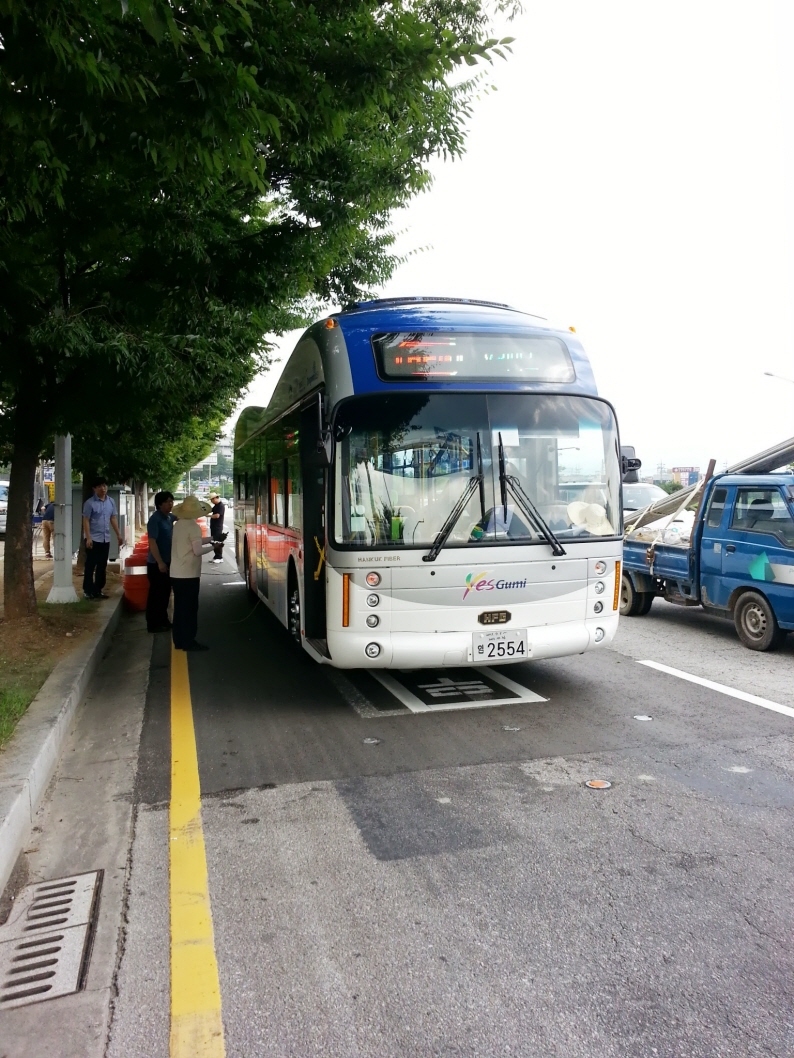South Korea Debuts Road-powered Electric Buses
South Korea's City of Gumi deploys two high tech electric buses.

This week the City of Gumi in South Korea is trialing a brand new type of electric bus that gathers a charge from the road beneath its wheels. Gumi has two of these new Online Electric Vehicle (OLEV) buses, which were developed by the KAIST Graduate School for Green Transportation and named one of the top 50 inventions of 2010 by Time Magazine.
The OLEV buses are environmentally friendly vehicles that draw electrical power from the road they're driving on via electrical cables that are buried under 5- to 15 percent of the surface of the road. The road is able to distinguish between regular vehicles and OLEV buses and will 'switch on' the power strips when OLEV buses pass along. The cables embedded in the asphalt create magnetic fields, and a receiver on the underside of the bus converts it all into the electricity to power the bus. The trial route for the buses stretches for 24 km and runs from Gumi station to the In-Dong district. According to KAIST (via Vice), the buses will receive 20 kHz and 100 kW (136 horsepower) electricity at an 85 percent maximum power transmission efficiency rate while maintaining a 17 cm air gap between the underbody of the vehicle and the road surface.
"It's quite remarkable that we succeeded with the OLEV project so that buses are offering public transportation services to passengers," said Dong-Ho Cho, a professor of the electrical engineering and the director of the Center for Wireless Power Transfer Technology Business Development at KAIST. "This is certainly a turning point for OLEV to become more commercialized and widely accepted for mass transportation in our daily living."
Gumi City plans to build a whole fleet of OLEV buses beginning at the end of the year, with plans to put 10 more on the road by 2015.
- Review: 2011 Chevy Volt
- Audi's Urban Concept Electric Car is Insanely Cool Looking
- Tesla Model S is the Electric Car of Our Dreams
Sign up to get the BEST of Tom's Guide direct to your inbox.
Get instant access to breaking news, the hottest reviews, great deals and helpful tips.
Jane McEntegart works in marketing communications at Intel and was previously Manager of Content Marketing at ASUS North America. Before that, she worked for more than seven years at Tom's Guide and Tom's Hardware, holding such roles as Contributing Editor and Senior News Editor and writing about everything from smartphones to tablets and games consoles.
-
DRosencraft This is a very sensible solution for vehicles, particularly public transportation. The problem comes with whether or not citizens/government will be willing to pay the money it takes to maintain the infrastructure of something like this over its lifetime, beyond just installing it.Reply -
hp79 Nice. This looks much better than the electric buses in SanFrancisco where they have electric wires all over the air.Reply -
back_by_demand I would be interested to see the comparison in real terms for emissions - those underground cables have 85% efficiency on electricity produced at a power station which still burns oil, coal or gas - perhaps some of the electricity comes from wind, nuclear or solar but the country will still only have that as a minority of the total - then compare that to modern highly efficient eco-diesel engines and then give us a call back. Until power stations are replaced with emission free alternatives then electric vehicles reducing said emissions are a myth.Reply -
ikyung @Back_by_demand - True, but also false. It depends on many variables, but in the big picture, electric vehicles do reduce emissions. Especially, in countries like South Korea, France, Switzerland, etc. Due to the fact that wind, nuclear, solar energy in countries as these is actually not the minority, but the majority. I believe South Korea gets about 1/3rd of the energy output of their entire country from Nuclear and is due to raise that to 50% by 2020. But, yes. Countries like China and India, won't really make a difference due to the fact most of their electricity is produced from oil or coal.Reply -
none12345 "I would be interested to see the comparison in real terms for emissions - those underground cables have 85% efficiency on electricity produced at a power station which still burns oil, coal or gas - perhaps some of the electricity comes from wind, nuclear or solar but the country will still only have that as a minority of the total - then compare that to modern highly efficient eco-diesel engines and then give us a call back. Until power stations are replaced with emission free alternatives then electric vehicles reducing said emissions are a myth. "Reply
Yes...and no...mostly no.
The thoretical maximum efficiency for a piston engine is about 40%. In the real world more like 25% would be considered good. And that would be peak real world effiency which only happens in a narrow power band. With lots of stop/start cycles you are usually at a much worse value.
Turbines on the other hand routinely operate in the 60% efficiency range in the real world. And they spend most of their time in their most efficient power range.
So they could drop down to ~45% transmission efficiency and still beat a good piston engine. At 85% they should be using about half the power.
Then there is the benefit of centralized power. Its far easier to control emissions on one power plant then 100,000 vehicles. And its far easier to replace 1 power plant with cleaner technology then to get 100,000 peopel to replace their old vehicles. As soon as a newer technology comes along that is cleaner you just replace the one centralized source, and everything down the line gets the benefit.
So yes its true its no zero emission, but worst case its far better. -
IndignantSkeptic Couldn't they design the bus to drop its induction coil closer to the road to increase the efficiency of the charging?Reply -
back_by_demand The 85% efficiency is from the electric in the cable to the vehicle, it loses more % the longer the cable is and some % from the power station - has anyone got any actual data instead of just guessing?Reply -
WyomingKnott Reply
http://media.bestofmicro.com/M/7/396079/original/OLEV.jpg11313971 said:Would someone please provide me a link to see bigger picture of the bus? Thx.
-
Anaxamenes I wonder how long the roadways last and how difficult they are to repair. The only problem I see is that we utilize sewer, natural gas and water under our roadways, so to redo out roads to this specification would be expensive and the US doesn't seem to be interested in repairing it's current infrastructure, let alone adding something new like this.Reply
I bet these buses are a lot quieter than diesel too, so it will improve not only particulate pollution but possibly noise pollution as well.
